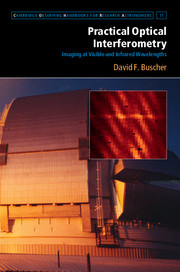Book contents
- Frontmatter
- Contents
- Principal symbols, functions and operators
- List of abbreviations
- Foreword
- Preface
- 1 Making fringes
- 2 Basic imaging
- 3 Atmospheric seeing and its amelioration
- 4 Interferometers in practice
- 5 Measurement noise
- 6 Interferometric observation of faint objects
- 7 Observation planning
- 8 Data reduction
- 9 Model fitting and image reconstruction
- Appendix A Fourier transforms
- Appendix B Supplementary online material
- References
- Index
9 - Model fitting and image reconstruction
Published online by Cambridge University Press: 05 August 2015
- Frontmatter
- Contents
- Principal symbols, functions and operators
- List of abbreviations
- Foreword
- Preface
- 1 Making fringes
- 2 Basic imaging
- 3 Atmospheric seeing and its amelioration
- 4 Interferometers in practice
- 5 Measurement noise
- 6 Interferometric observation of faint objects
- 7 Observation planning
- 8 Data reduction
- 9 Model fitting and image reconstruction
- Appendix A Fourier transforms
- Appendix B Supplementary online material
- References
- Index
Summary
The OIFITS files produced at the end of the data-reduction process can be used to provide information about the object under study. There are two ways in which this information can be extracted, either in terms of parameters of a relatively simple model, or as a model-independent image. These two forms of information are related to one another and are often used in tandem. This chapter discusses the process of deriving these end products of an interferometric observation.
Bayesian inference
In Chapter 8 the overall inverse problem of interferometry was presented as the problem of determining the parameters of a model of the object being observed from the measured data values. The data-reduction process presented in that chapter does not fundamentally change that problem: the object model parameters still need to be determined, but, as the name implies, the data-reduction process reduces the volume of data that need to be considered.
Indeed, the remaining problem is not one of data reduction but of data interpretation, as the number of data points produced by the data-reduction process may be comparable to or even less than the number of model parameters. This kind of under-constrained problem is where a form of inference known as Bayesian inference is at its best.
Bayesian inference acknowledges the non-uniqueness of the model parameters in the majority of inverse problems. Instead of selecting a single model (for example a parameterised model together with a single set of values for the model parameters) which could have produced the data, it acknowledges that there may be many possible models and assigns a probability P between 0 and 1 to all of them in parallel.
- Type
- Chapter
- Information
- Practical Optical InterferometryImaging at Visible and Infrared Wavelengths, pp. 218 - 247Publisher: Cambridge University PressPrint publication year: 2015



